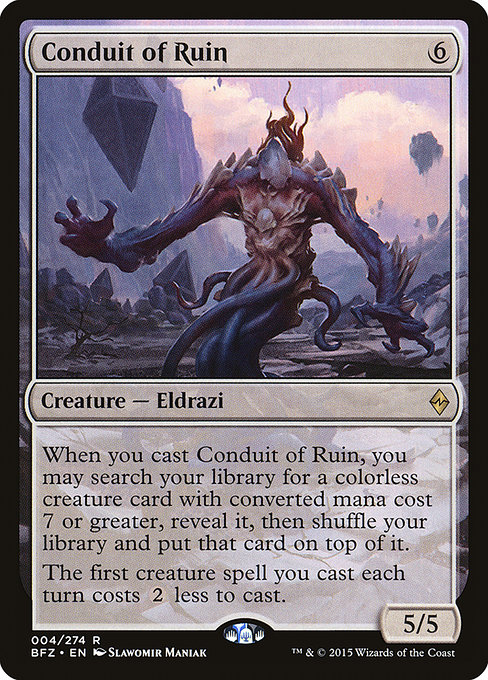
Image courtesy of Scryfall.com
Conduit of Ruin Sparks Evolving MTG Lore Arcs
In the vast tapestry of Magic: The Gathering, the storylines are often threaded through the mechanics themselves. Conduit of Ruin, a rare Eldrazi creature from Battle for Zendikar (BFZ), embodies that idea in a bold, motion-filled way. Its presence isn’t just about raw numbers or a flashy ability; it signals how MTG’s ongoing narrative keeps spiraling outward, revealing new eldritch currents that fans chase across formats and storylines 🧙♂️🔥. As a colorless Eldrazi with a heavy-hitting mana cost of six, Conduit of Ruin arrives with a dual purpose: it acts as a narrative conduit—linking you to a towering, colorless threat—and it delivers a practical tool for deck architects who love tempo and top-teaching reveals. The card’s lore-laden flavor sits at the intersection of the Zendikar crisis and the broader Eldrazi saga, where cosmic hunger and unexpected echoes shape the battlefield ⚔️.
Mechanically, Conduit of Ruin does something that feels almost cinematic: when you cast it, you may search your library for a colorless creature card with mana value 7 or greater, reveal it, shuffle, and put that card on top. That “look ahead” moment is a narrative wink—the Eldrazi mind-mendiscent may glimpse a bigger threat looming just beyond the top of your library, a threat that will soon surge into the scene. Then the card’s second line—“The first creature spell you cast each turn costs 2 less to cast”—offers a tempo-twisting engine. It’s not just about casting a big behemoth early; it’s about configuring your turn sequencing so that the next giant colorless creature slides into play with surprising speed. In a sense, you’re not just playing a card; you’re guiding a story beat, a cliffhanger that resolves with a monumental arrival 🧨💎.
In Zendikar, knowledge is revelation—the top of the library is a window, not a wall, and Conduit of Ruin makes that window part of the plan.
The lore around Conduit of Ruin also leans into the broader mythos of the Eldrazi: ancient, colorless powers that bend reality and feed on mana. BFZ’s setting leaned into the idea that the Multiverse’s primordials aren’t merely forces of destruction; they are architects of new narrative arcs, reshaping how players think about patience, inevitability, and power. By enabling a search for a 7-plus colorless creature and placing it on top, Conduit of Ruin invites players to imagine the “next big thing” looming just ahead—mirroring how the story threads in MTG often hinge on a single, destiny-filled card entering the scene at the pivotal moment 🧙♂️🎨. It’s a mechanic that rewards foresight and planful tension in both casual games and tournament-caliber plays 🔥.
Storytelling Through Mechanics: How Evolving Arcs Find Their Pulse
- Top-deck storytelling: The “put that card on top” effect is a rare narrative device. It turns deck-building into a storyboard, where you craft a sequence leading to a dramatic reveal—a hallmark of evolving arcs that the game loves to showcase.
- Tempo with a purpose: The cost reduction on the first creature spell each turn isn’t just a tempo blip. It acts as a narrative beat that nudges you toward a climactic moment when a fearsome colorless creature resolves and changes the mood of the battlefield.
- Eldrazi as ongoing antagonists: Conduit of Ruin isn’t a one-set cameo. It participates in the long arc of Zendikar’s saga, reminding players that the Eldrazi’s influence isn’t over when a single card hits the battlefield—it's a thread that DC-level books explore across blocks 🧠⚔️.
- Colorless identity and design language: The card’s identity—colorless, Eldrazi, big mana value—echoes the ongoing design philosophy that colorless power can shape strategic diversity. It blends power with narrative ambiguity: what color, what threat, what plan comes next?
- Collector narratives and lore-driven formats: As BFZ-era lore echoes into present-day storylines, cards like Conduit of Ruin become touchpoints for fans who follow the broader implications of the Eldrazi crisis in modern storytelling and game design 🧩💬.
From a collector’s lens, Conduit of Ruin stands out in the BFZ slot. It’s a rare colorless creature with a commanding presence, illustrated by Slawomir Maniak, and it reflects the era’s fascination with cosmic threats and top-deck drama. In terms of playability, the card is versatile enough to slot into Modern- and Legacy-legal shells, with Commander embracing a broader spectrum of colorless opportunities. Its foil and nonfoil finishes add a tactile layer to a narrative that’s already rich with myth and memory. A card like this not only powers a deck; it roots a moment in MTG’s evolving lore, turning a single battlefield encounter into a memory you’ll revisit when you discuss the Fenrir price shifts, the Mace of mana themes, and the broader conversations around how Eldrazi continue to shape the multiverse 🧙♂️💫.
When you’re traveling to events or simply wanting to keep your collection organized while you chase the next chapter of the story, a sturdy phone case with a card holder can be a practical companion. This particular MagSafe polycarbonate case (glossy or matte) keeps your device safe and your accessories close—a tiny nod to the kind of practical, on-the-go gear fans appreciate as they juggle playmats, tokens, and travel decks. It’s a small, real-world artifact that echoes MTG’s blend of strategy, lore, and everyday joy 🎲.
Product spotlight: MagSafe Polycarbonate Phone Case with Card Holder — Glossy or Matte. Buy it here: Magsafe Polycarbonate Phone Case with Card Holder Glossy or Matte.
More from our network
- https://transparent-paper.shop/blog/post/subtle-texture-techniques-for-rich-web-backgrounds/
- https://blog.rusty-articles.xyz/blog/post/manaforce-mace-debuts-mtg-community-reactions-and-first-impressions/
- https://crypto-acolytes.xyz/blog/post/best-pc-controllers-for-smooth-precise-gaming/
- https://blog.digital-vault.xyz/blog/post/summon-fenrir-regional-price-gaps-and-collector-behavior/
- https://crypto-acolytes.xyz/blog/post/understanding-solana-based-stablecoin-risks-for-investors/